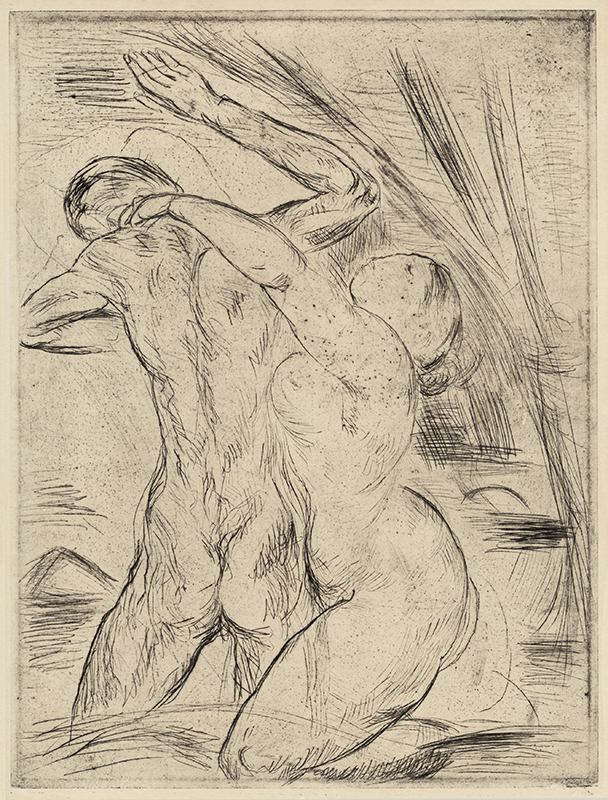
19th, 20th & 21st Century Fine Prints
707-546-7352 · fax 707-546-7924 · web: www.annexgalleries.com · email: artannex@aol.com
Potiphar's Wife (Potiphars Weib) by Wilhelm Lehmbruck

Potiphar's Wife (Potiphars Weib)
Wilhelm Lehmbruck
Potiphar's Wife (Potiphars Weib)
Wilhelm Lehmbruck
1881 - 1919 (biography)Wilhelm Lehmbruck is unfortunately often remembered as a German Expressionist sculptor who suffered from depression after his experiences as a soldier in WWI and whose work was later classified as 'Degenerate' by Hitler and the Nazis. Lehmbruck committed suicide at age 38 but left a legacy of powerful sculptures and prints that reflected his personal angst.
His main productive period was between 1910 and 1919. He is recognized for his sketch-like style in drypoints, lithographs and engravings depicting one or more slender and emotional figures often expressing sad and mournful gestures.
"Potiphar's Wife" is an excellent example of his printed work using drypoint and etching to capture a biblical subject. The story in Genesis alleges that the slave Joseph had been put in control of the estate and household of wealthy Egyptian Potiphar, whose wife (who is never named) had not had any children and was bored by Potiphar. She became enamoured of Joseph and attempted to seduce him but he refused, the subject of this composition. She, in anger, accused him of attempted rape and he was arrested and jailed by Potiphar where he began to interpret the Pharoah's dreams.
Wilhelm Lehmbruck was born in Meiderich Germany, on Jaunary 4, 1881, As a youth, his talent for visual art was awarded with a stipend from municiple officals to study at the School of Applied Arts in Düsseldorf. By 1899 he was supporting himself financially by doing illustrations for scientific publications. This allowed him to train at the Kunstakademie Düsseldorf, and he became associated with the Düsseldorf School of painting from 1901 to 1906. In 1904 a visit to the International Art Exhibition, Düsseldorf, changed his artistic path: his discovery of the work of Auguste Rodin, so unlike the decorative, neo-classical style Lehmbruck was familiar with, appealed to his own introspective and emotive style.
In 1910 the Lehmbrucks moved to Paris. Wilhelm would frequent the Café du Dôme where he became acquainted with fellow modernists Modigliani, Brâncu?i, and Archipenko, and he was able to secure an introduction to Rodin. His reputation was such that he had regular collectors, and that year he was approached by Berlin publisher Paul Cassirer with an offer to publish small editions of Lehmbruck's drypoints, which had gained recognition for their sketch-like, sensitive beauty. This would prove a lasting and successful partnership, and Cassirer would print the final edition after Lehmbruck's death.
The onset of World War I forced the Lehmbrucks to return to Germany, and Wilhelm served as a paramedic at a military hospital in Berlin, allowing him some time to continue working. The hospital took a toll, however, and the misery he witnessed there was reflected in his late work, such as the sculpture Fallen Man (1915–16). He himself suffered from depression which was exacerbated by this experience, and, after being released from his duties due to a hearing impairment in 1916, he moved his family to Switzerland to wait out the war and to attempt to relieve his distress. In Zurich he made contact with the socialist L. Rubiner, who collaborated on Franz Pfemfert's Aktion, and with the Expressionist dramatist Fritz von Unruh and the poet Albert Ehrenstein. These connections inspired his work and cemented his political stance; however, at this time his marriage began to crumble and his mental health began to decline.
In 1919, just after the end of the war, he returned to Berlin to work on a commission, and was offered a position at the Prussian Academy of Arts. However, he could not escape his crippling depression and, just six days after his return, he committed suicide on March 25, 1919.


